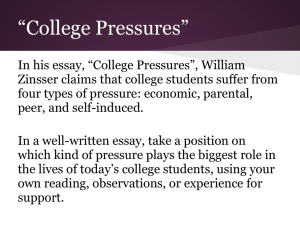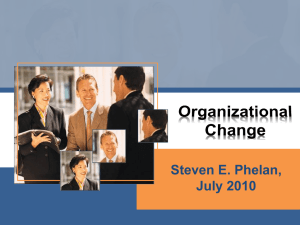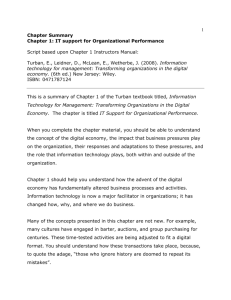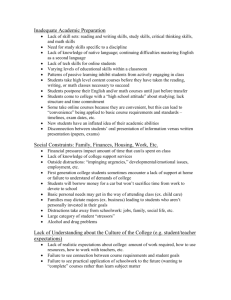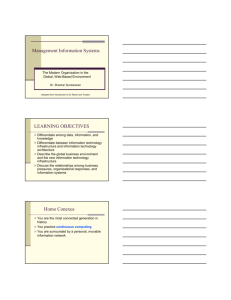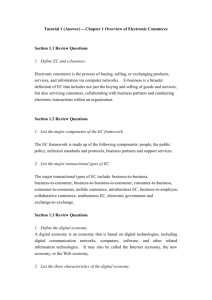Organization Design
advertisement
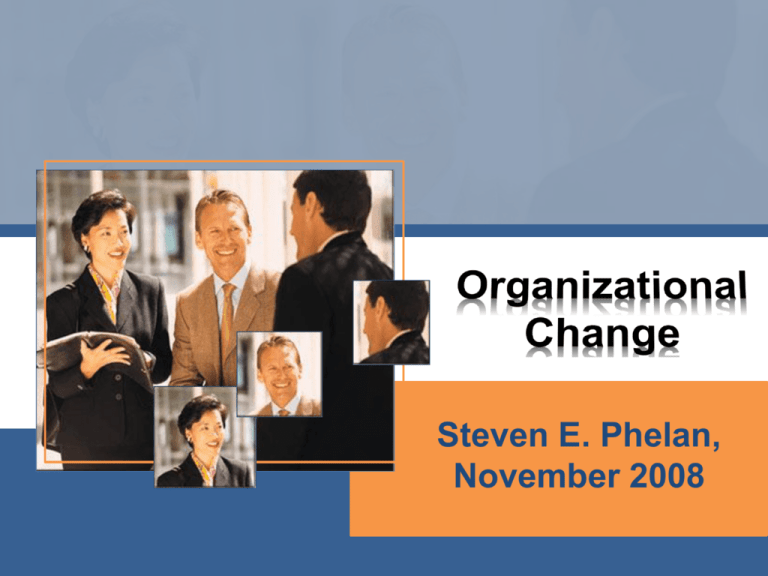
Steven E. Phelan, November 2008 • Change is a risky activity • Many organizational changes fail or do not realize their intended outcomes (50-70%). • This raises the question of why change is so prevalent? • Pressure to change comes from: • External, environmental pressures • Internal, organizational pressures Pressure Market decline pressures Hypercompetition pressures Reputation and credibility pressures Examples Description Harley Davidson When current markets that the organization operates in begin to decline there is pressure to find newer, more viable markets. Intel This affects the way organizations respond to their consumers and their competitors to cater for the increasingly rapid pace of business. Walt Disney Company In light of recent corporate governance scandals in organizations, the pressure to maintain a good reputation and high level of credibility has increased. Pressure Fashion pressures Mandated pressures Geopolitical pressures Examples Description Boeing Co. This is based on mimetic isomorphism – imitating companies that are legitimate and successful Chevron Texaco This is based on coercive isomorphism – when change is demanded by outside sources. 3M This is when global crises greatly impact an organization and change is necessary for survival. Pressure Growth pressures Integration and collaboration pressures Identity pressures Examples Description Microsoft Existing systems and processes in a smaller organization may no longer be applicable when the size of the organization increases. EDS Integration and creating economies of scale can lead to pressure for change in organizations. Forte Hotel A common organizational identity and the unified commitment of staff in different areas/departments of an organization can be difficult to manage and may encourage change. Pressure New broom pressures Power and political pressures Examples Description UNLV New authority figures in an organization can herald a new era and often signal significant changes an organization in an organization. Morgan Stanley Power relationships and politicking can change internal processes and decision making. This has significant flow on effects within the organization. • Take five minutes to personally answer these questions: • Have you (or someone you know) ever experienced organizational change? • What was your view of the change? • What did others think of the change? • Who were the change champions? How did they behave? • Perform the following activities in your group: • Share your stories with members of your group • What are the common issues? • What are the differences? • Are there “lessons” embedded in these stories? • What three conclusions do you draw from these stories about managing change? • Controlling… – Top-down view of management – Fayol’s theory of management: planning, organizing, commanding, coordinating and controlling. • Shaping… – Participative style of management – Improving the capabilities of people within the organization • Intended Change: – Change is a result of planned action • Partially Intended Change: – Change may need to be re-modified after it is initially implemented • Unintended Change: – Forces beyond the control of the change manager Images of Managing Controlling . . . Shaping . . . (activities) (capabilities) Images of Change Outcomes Intended DIRECTOR COACH Partially Intended NAVIGATOR INTERPRETER Unintended CARETAKER NURTURER Coach Director • Relies upon building in • Based on an image of the right set of values, management as control skills and “drills” that are and of change outcomes deemed to be the best as being achievable. ones that organizational • Supported by the n-step members will be able to models and contingency draw on in order to achieve desired theory. organizational outcomes. • Related to organizational development approaches. Navigator Interpreter • Control is still seen to be at • The manager creates the heart of management meaning for other action, although a variety of organizational members, factors external to helping them to make sense managers mean that while of various organizational they may achieve some events and actions. intended change outcomes, • Supported by the senseothers will occur over which making theory of they have little control. organizational change and • Supported by the concept of ‘enactment’ contextualist and processual theories of change. Nurturer Caretaker • Even small changes may • The change manager’s have a large impact on ability to control is organizations and severely impeded by a managers are not able to variety of internal and control the outcome of external forces beyond these changes. However, the scope of the they may nurture their manager. The caretaker organizations, facilitating is seen as shepherding organizational qualities their organizations along that enable positive selfas best they can. organizing to occur. • Supported by life-cycle, • Related to chaos and population-ecology and Confucian/Taoist theories. institutional theories. • To what extent are you more comfortable with one or other of the six images? • Why is this the case? • What are the strengths and limitations of the images that you have identified as most relevant to you? • What skills do you think are associated with each image? • Are there areas of personal skill development that are needed for you to feel more comfortable in using other images? • Have you ever been in an organization that was dominated by particular images? • What barriers to alternative images existed in this organization? What strategies could overcome these barriers? • Surfacing our assumptions about change • Images simplify & illuminate but also obscure • Assessing dominant images of change • To what degree are some images seen as natural and not open to negotiation in certain organizations • Using multiple images in change • Image-in-use might depend on the type of change • Image-in-use might depend on the context • Image-in-use might depend on the phase of change • Multiple change images can also co-exist • Skilled change managers are able to swap images or even manage multiple images simultaneously • Typical questions about change: • • • • Was it managed well? What went right? What went wrong? Did we get the outcome we were after? • Do these questions assume a certain image of change? • How does each image assess success? • Which images have “non-traditional” success measures? • “Judgments of success are conditional on who is doing the assessment and when the judgments are made” Is this true? • Take your group’s stories from earlier in the day • Which images of change did you come across? • How did these images affect the way the various actors approached change? • Do the images used vary by the type, context, or phase of change? • What broad conclusions can you form? • Questions: • Which of the six change images were held by: • Gunter? • The hospitality literature? • The consultant? • How did these assumptions influence prescriptions for dealing with “the turnover problem” • What does it mean to say the problem was ‘dissolved’? • Choose another change image and apply it to “the turnover problem” What new insights arise? • Does considering different images of change help us (I hesitate to add ‘solve the problem’)? • The goal of change management is to dupe slow-witted employees into thinking change is good for them by appealing to their sense of adventure and love of challenge • This is like convincing a trout to leap out of a stream to experience the adventure of getting deboned Active signs of resistance Passive signs of resistance • Being critical • Agreeing verbally but not • Finding fault following through (“malicious • Ridiculing compliance”) • Failing to implement change • Appealing to fear • Procrastinating or dragging • Using facts selectively one’s feet • Blaming or accusing • Feigning ignorance • Sabotaging • Withholding information, • Intimidating or suggestions, help, or support threatening • Standing by and allowing change to fail • Manipulating • Distorting facts •Which of the various ways of resisting • Blocking change are the most common? • Undermining. •Which are the most difficult to deal with? • Starting rumors • Arguing • Dislike of change • People don’t resist change, they resist pain! • Boredom can be pain, too. • Discomfort with uncertainty • Low tolerance for ambiguity • Perceived negative effects of interests • Authority, status, rewards, salary, social ties • Attachment to the established culture/ways of doing things • Perceived breach of psychological contract • Lack of conviction that change is needed • Lack of clarity as to what is needed • Belief that the specific change being proposed is inappropriate • Belief that the timing is wrong • Excessive change • Cumulative effects of other changes in one’s life • Perceived clash with ethics • Reaction to the experience of previous changes • Disagreement with the way the change is being managed • • • • • • • • • Security Money Authority Status/prestige Responsibility Better working conditions Self-satisfaction Better personal contacts Less time and effort • The classic steps: • Education and communication • Participation and involvement • Facilitation and support • Beyond the classic steps: • Negotiation and agreement • Manipulation and cooptation • Explicit and implicit coercion • The Paula Story • Does a successful change manager needs skills in all six areas? • Where do you need development? • Resistance is a natural (even necessary) psychological stage in any change: • • • • Denial / Resistance / Exploration / Commitment / Shock Anger Mourning Acceptance • Do we just ‘let nature take its course’ then? • Can people get stuck in a stage? • Use the power of resistance to build support • Showing respect towards resistors creates stronger relationships and thereby improves the prospects of success • Fundamental touchstones • • • • • Maintain clear focus Embrace resistance Respect those who resist (assume good faith) Relax Join with the resistance • Look for points of commonality • • • • • • • • Use power Manipulate those who oppose Apply force of reason Ignore resistance Play off relationships Make deals Kill the messenger Give in • Contingency approaches challenge the view that there is “one best way” • The style of change will vary, depending upon the scale of the change and the receptivity of organizational members for engaging in the change. • Kotter and Schlesinger recommend changing tactics according to the: • Amount and kind of resistance anticipated • The position and power of the change agent • The personality of the person designing and implementing the change • The time available and the consequences of failure • Which approach to the management of resistance attracts you? Why? • Task • Develop a formal integration plan (with decisions on branch closures, systems conversion, product alignment, layoffs, and communication strategy) that will maximize shareholder value while keeping as much support as possible from the stakeholders at the two banks and external organizations. • 10 minutes = 1 news cycle = 1 day NORTHERN BANK CEO Heather CIO Henry VP-HR Seth VP-Retail Banking Ed SOUTHERN BANK CEO Allison CIO Maureen VP-HR Paul VP-Retail Banking Kim • Other Roles • • • • • • • • Change Manager: Tod Journalist: Lorri Union Organizer: Anita State Regulator: Keith Admin Assistant: Scott EastWest Bank: Brian Largest Customer: Kris Branch Employee: Jocylene Donna Dubinsky
